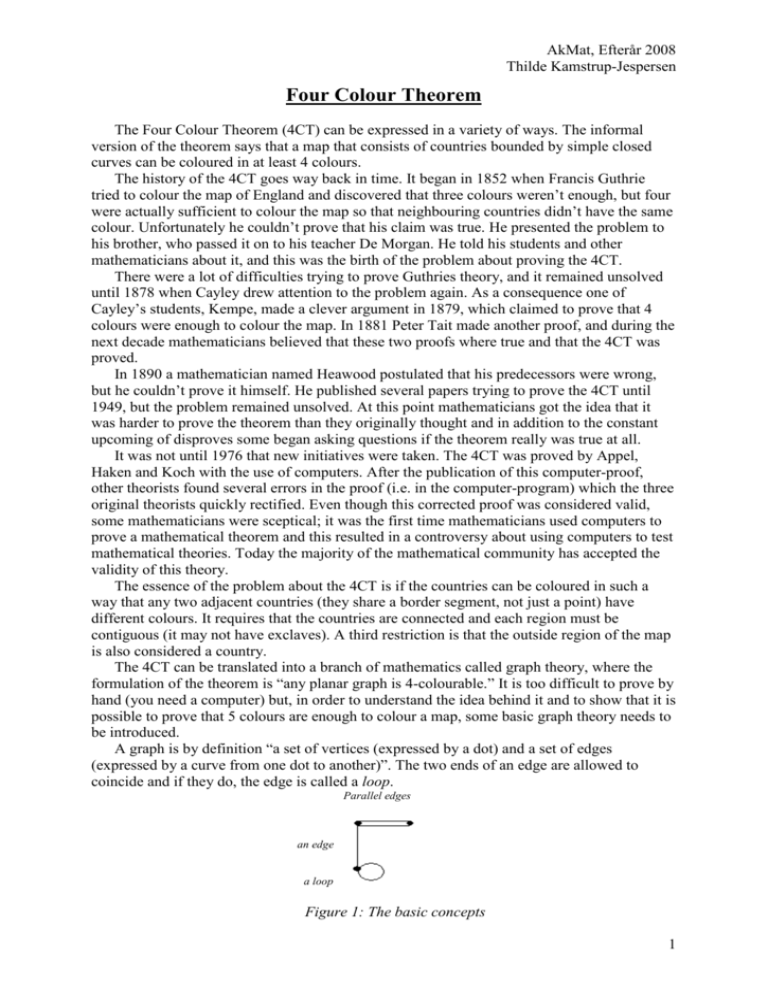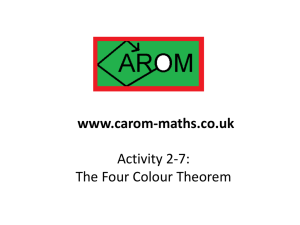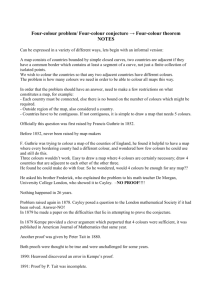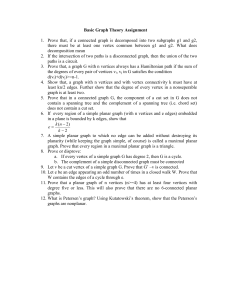Four Colour Theorem
advertisement

AkMat, Efterår 2008 Thilde Kamstrup-Jespersen Four Colour Theorem The Four Colour Theorem (4CT) can be expressed in a variety of ways. The informal version of the theorem says that a map that consists of countries bounded by simple closed curves can be coloured in at least 4 colours. The history of the 4CT goes way back in time. It began in 1852 when Francis Guthrie tried to colour the map of England and discovered that three colours weren’t enough, but four were actually sufficient to colour the map so that neighbouring countries didn’t have the same colour. Unfortunately he couldn’t prove that his claim was true. He presented the problem to his brother, who passed it on to his teacher De Morgan. He told his students and other mathematicians about it, and this was the birth of the problem about proving the 4CT. There were a lot of difficulties trying to prove Guthries theory, and it remained unsolved until 1878 when Cayley drew attention to the problem again. As a consequence one of Cayley’s students, Kempe, made a clever argument in 1879, which claimed to prove that 4 colours were enough to colour the map. In 1881 Peter Tait made another proof, and during the next decade mathematicians believed that these two proofs where true and that the 4CT was proved. In 1890 a mathematician named Heawood postulated that his predecessors were wrong, but he couldn’t prove it himself. He published several papers trying to prove the 4CT until 1949, but the problem remained unsolved. At this point mathematicians got the idea that it was harder to prove the theorem than they originally thought and in addition to the constant upcoming of disproves some began asking questions if the theorem really was true at all. It was not until 1976 that new initiatives were taken. The 4CT was proved by Appel, Haken and Koch with the use of computers. After the publication of this computer-proof, other theorists found several errors in the proof (i.e. in the computer-program) which the three original theorists quickly rectified. Even though this corrected proof was considered valid, some mathematicians were sceptical; it was the first time mathematicians used computers to prove a mathematical theorem and this resulted in a controversy about using computers to test mathematical theories. Today the majority of the mathematical community has accepted the validity of this theory. The essence of the problem about the 4CT is if the countries can be coloured in such a way that any two adjacent countries (they share a border segment, not just a point) have different colours. It requires that the countries are connected and each region must be contiguous (it may not have exclaves). A third restriction is that the outside region of the map is also considered a country. The 4CT can be translated into a branch of mathematics called graph theory, where the formulation of the theorem is “any planar graph is 4-colourable.” It is too difficult to prove by hand (you need a computer) but, in order to understand the idea behind it and to show that it is possible to prove that 5 colours are enough to colour a map, some basic graph theory needs to be introduced. A graph is by definition “a set of vertices (expressed by a dot) and a set of edges (expressed by a curve from one dot to another)”. The two ends of an edge are allowed to coincide and if they do, the edge is called a loop. Parallel edges an edge a loop Figure 1: The basic concepts 1 AkMat, Efterår 2008 Thilde Kamstrup-Jespersen The number of edges that ends/begins in the vertex is called the degree of a vertex, and when all the vertices are connected to each other by one edge, so that every pair of vertices is adjacent, the graph is a complete graph. When there is a walk (a sequence of vertices and edges - each incident to the next) from one vertex to all the others, with every pair of vertices connected, the graph is connected. Furthermore a planar graph is a graph that can be represented in a plane without any edges intersecting away from the vertices (no vertices are crossing each other). A graphical representation of a planar graph without edge intersections is called a plane drawing. So a planar graph is a graph that is isomorphic to a plane graph. The regions that are separated from each other by edges of a plane drawing (a graphic rotation of a planar graph) are called faces. If you place a vertex in each face and then construct edges such that each edge crosses one of the original edges and connects the vertices on either side of that edge, you get the dual graph. Degree of a vertex a complete graph planar graph and its plane drawing Figure 2: Illustration of some of the definitions. The 4CT is part of a larger general problem of graph-colourings. It asserts that any map, consisting of a planar graph, called the underlying graph, can have its faces (the regions) coloured with 4 different colours or less. The notion of duality is very important because it allows us to relate the colouring of faces to the colouring of vertices. By proving the 4CT, it is equivalent to prove that no planar graph requires more than 4 colours to colour its vertices. It was the famous Swiss mathematician Euler, who ‘invented’ graph-theory when he was trying to solve the “Königsberg Bridge Problem”. The problem was to find a walking route around the city that crossed each bridge exactly once and ended at the starting point. This can be expressed in the language of graph-theory by replacing the land areas by vertices and the bridges between them by edges. Euler announced a formula which was applied to any connected map (i.e. a plane graph) called ‘The Euler Formula’. It says that when G is a plane drawing of a connected graph with E number of edges, V number of vertices and F number of faces, then E–V+F=2 The formula is proved by induction on E, and in corollary to it, Euler claimed that every plane connected graph contains a vertex of degree 5 or less. By using Eulers formula, the corollary and the definitions above, the theorem saying that all maps are 5-colourable, can be proved. The idea behind the proof is to show that any dual graph is 5-colourable. This is done by induction on the number of vertices V in the graph. According to Eulers corrollary there is a vertex v of a degree 5 or less in the graph and by changing the colours of the neighbouring vertices to v so only four colours are represented, the fifth colour can be used to colour the vertex v and the theorem is thereby proved. So far the discussion has been about the spherical surface (as we drew the graphs in the plane); but what about the orientable surface? For a torus, which has the shape of a doughnut, seven colours are sufficient to colour a map on the surface. This was proved by Heawood in 1890 (in the same paper where he showed that Kempe’s proof of the 4CT was wrong). 2 AkMat, Efterår 2008 Thilde Kamstrup-Jespersen Figure 3: 7 colours are enough to colour the surface of a torus. The torus is a graph of genus g = 1, which means that the doughnut has one “hole”. Heawood generalized this to arbitrary surfaces and said that if g ≥ 2 then every planar graph on a surface of genus g is k-colourable where This number is called ‘The Heawood number’ of the surface. The eventual proof of the 4CT from 1976 relies on graph-theory too. There are two main principles in the proof: ‘discharging’ and ‘reducibility’. Reducibility means that the configurations can be reduced to smaller cases, which by induction can be assumed fourcolourable. Discharging produces a long list of ‘unavoidable configurations’ (i.e. every graph must contain at least one of these configurations) and afterwards each of these configurations should be proved reducible. This will then provide an inductive proof of the 4CT. Appel, Haken and Koch demonstrated that the infinity of possible maps could be represented by 1936 unavoidable configurations (at least one of which must be present in any graph, no matter how large) which had to be checked one by one by computer. These were all reducible. In 1996 a more efficient version of the proof was done by Robertson, Sanders, Seymour and Thomas. Their proof reduced the complexity of the problem and required checking only 633 reducible configurations. Both the unavoidability and reducibility parts of this new proof must be executed by computer, because it is too impractical to check by hand. Today most have accepted this proof as the valid proof of the Four Colour Theorem. 3








